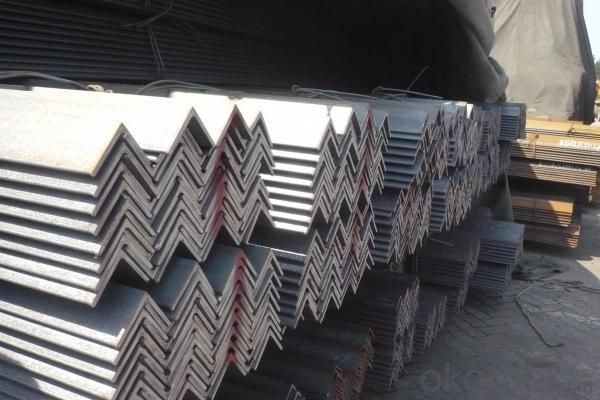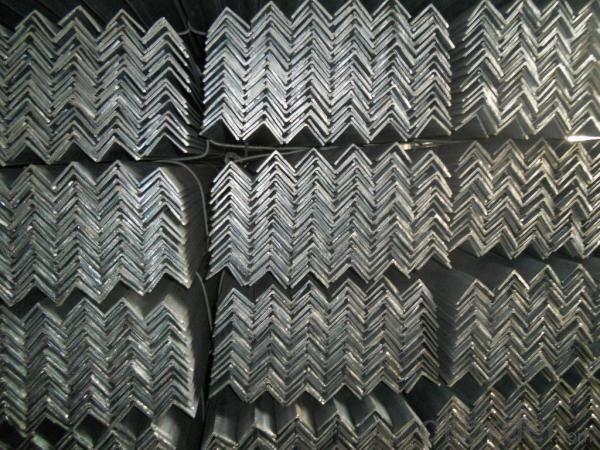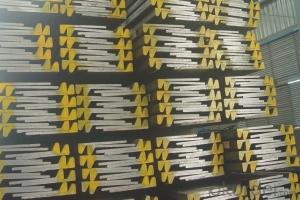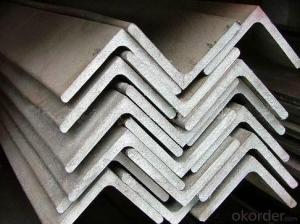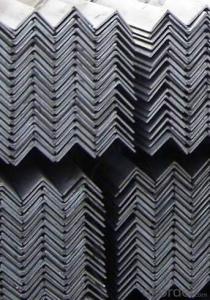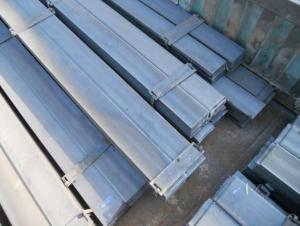JIS SS400 Angle Steel
- Loading Port:
- China Main Port
- Payment Terms:
- TT or LC
- Min Order Qty:
- 25mts m.t.
- Supply Capability:
- 80000-100000MTS/YEAR m.t./month
OKorder Service Pledge
OKorder Financial Service
You Might Also Like
Specifications of JIS SS400 Angle Steel
1.Standards:GB,ASTM,BS,AISI,DIN,JIS
2.Invoicing on theoretical weight or actual weight as customer request
3.Material: JIS G3192,SS400;SS540.
4. Payment terms:
1).100% irrevocable L/C at sight.
2).30% T/T prepaid and the balance against the copy of B/L.
3).30% T/T prepaid and the balance against L/C
5.Sizes:

EQUAL ANGLES SIZES |
| ||
a(mm) | a1(mm) | thickness(mm) | length |
25 | 25 | 2.5---3.0 | 6M/12M |
30 | 30 | 2.5---4.0 | 6M/12M |
38 | 38 | 2.5 | 6M/12M |
38 | 38 | 3.0---5.0 | 6M/12M |
40 | 40 | 3.0---6.0 | 6M/12M |
50 | 50 | 3 | 6M/12M |
50 | 50 | 3.7---6.0 | 6M/9M/12M |
60 | 60 | 5.0---6.0 | 6M/9M/12M |
63 | 63 | 6.0---8.0 | 6M/9M/12M |
65 | 65 | 5.0---8.0 | 6M/9M/12M |
70 | 70 | 6.0---7.0 | 6M/9M/12M |
75 | 75 | 5.0---10.0 | 6M/9M/12M |
80 | 80 | 6.0---10.0 | 6M/9M/12M |
90 | 90 | 6.0---10.0 | 6M/9M/12M |
100 | 100 | 6.0---12.0 | 6M/9M/12M |
120 | 120 | 8.0-12.0 | 6M/9M/12M |
125 | 125 | 8.0---12.0 | 6M/9M/12M |
130 | 130 | 9.0-12.0 | 6M/9M/12M |
140 | 140 | 10.0-16.0 | 6M/9M/12M |
150 | 150 | 10---15 | 6M/9M/12M |
160 | 160 | 10---16 | 6M/9M/12M |
180 | 180 | 12---18 | 6M/9M/12M |
200 | 200 | 14---20 | 6M/9M/12M |
5. Material Specifications:
Grade | Yield Strength,N/mm² | Extension Strength N/mm² | |||
Thickness of Steel,mm | |||||
≦16 | >16-≦40 | >40-≦100 | >100 | ||
SS330 | ≧205 | ≧195 | ≧175 | ≧165 | 330-430 |
SS400 | ≧245 | ≧235 | ≧215 | ≧205 | 400-510 |
SS490 | ≧285 | ≧275 | ≧255 | ≧245 | 490-610 |
SS540 | ≧400 | ≧390 | - | - | ≧540 |
Usage & Applications JIS SS400 Angle Steel
Trusses;
Transmission towers;
Telecommunication towers;
Bracing for general structures;
Stiffeners in structural use.
Packaging & Delivery of JIS SS400 Angle Steel
1. Transportation: the goods are delivered by truck from mill to loading port, the maximum quantity can be loaded is around 40MTs by each truck. If the order quantity cannot reach the full truck loaded, the transportation cost per ton will be little higher than full load.
2. With bundles and load in 20 feet/40 feet container, or by bulk cargo, also we could do as customer's request.
3. Marks:
Color mark: There will be color marking on both end of the bundle for the cargo delivered by bulk vessel. That makes it easily to distinguish at the destination port.
Tag mark: There will be tag mark tied up on the bundles. The information usually including supplier logo and name, product name, made in China, shipping marks and other information request by the customer.
If loading by container the marking is not needed, but we will prepare it as customer request.
Production flow of JIS SS400 Angle Steel
Material prepare (billet) —heat up—rough rolling—precision rolling—cooling—packing—storage and transportation


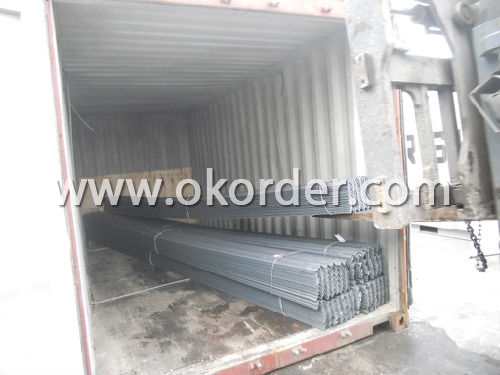
- Q:Can steel angles be used for support structures in stadiums or arenas?
- Certainly! Support structures in stadiums or arenas can utilize steel angles. Due to their strength, durability, and versatility, steel angles are commonly employed in construction and engineering projects. They are frequently employed in structural applications that necessitate load-bearing support, rendering them suitable for supporting the weight of stadium or arena structures. Steel angles can serve as beams, columns, or trusses, delivering the requisite support and stability for sizable structures. Their capacity to withstand substantial loads and resist bending or warping makes them a favored option for constructing stadium roofs, grandstands, and other support systems. Furthermore, steel angles can be easily fabricated and tailored to meet specific design requirements, enabling efficient and cost-effective construction of stadium and arena support structures.
- Q:How do steel angles provide structural support?
- Structural support is provided by steel angles, which evenly and efficiently distribute weight and load in a structure. These L-shaped steel beams are commonly used in construction. The stability and strength of the angle's two legs enable it to resist bending and twisting forces. Steel angles are frequently combined with other structural components like beams, columns, and trusses to establish a stable framework. They can be connected to these components through bolting, welding, or other methods to offer additional support and reinforcement. Due to their versatility, steel angles can be utilized in various applications, including building frames, supports, bracing, and structural reinforcement. The incorporation of steel angles in a structure helps evenly distribute weight and load across different components, reducing the risk of structural failure. They effectively resist compressive, tensile, and bending forces, providing stability and preventing deformation under heavy loads or external forces like wind or earthquakes. Furthermore, steel angles serve to create secure connections and joints between different parts of a structure, ensuring their firm fastening. This enhances overall stability and integrity, making the structure more resistant to movement, vibrations, and other external factors that could compromise safety. In summary, steel angles play a vital role in providing structural support. They distribute weight, resist bending and twisting forces, enhance stability, and reinforce connections between different structural components. Their strength, versatility, and reliability make them a popular choice in construction projects where structural integrity and stability are paramount.
- Q:Are steel angles suitable for manufacturing shelving units?
- Yes, steel angles are suitable for manufacturing shelving units. Steel angles provide excellent structural support and stability, making them an ideal choice for shelving systems. They can withstand heavy loads and distribute weight evenly, ensuring the durability and longevity of the shelving units. Moreover, steel angles are easy to work with and can be customized to fit specific dimensions and designs. They are also resistant to corrosion and can withstand harsh environmental conditions, making them suitable for both indoor and outdoor shelving units. Overall, steel angles offer the strength, versatility, and reliability needed for manufacturing high-quality and long-lasting shelving units.
- Q:How do you design connections for steel angles to concrete?
- To design connections for steel angles to concrete, several factors need to be considered. Firstly, the load requirements and type of connection (such as shear, tension, or moment) must be determined. Then, appropriate connection methods like embedded plates, anchor bolts, or post-installed anchors can be selected. The design must also consider the concrete strength, angle size, spacing, and edge distances. Detailed calculations are performed to ensure the connection is safe and meets the applicable design codes and standards. Additionally, factors like corrosion protection and construction feasibility should be considered during the design process.
- Q:Can steel angles be used in the construction of bridges?
- Yes, steel angles can be commonly used in the construction of bridges. Steel angles are versatile structural components that can provide additional strength and support to bridge structures. They are often used in the construction of bridge decks, railings, and supports. Steel angles are known for their high strength-to-weight ratio, which makes them ideal for bridge construction. They can withstand heavy loads and provide stability to the bridge structure. Additionally, steel angles are durable and resistant to corrosion, which is essential for bridges that are exposed to various environmental conditions. In bridge construction, steel angles are often used in conjunction with other steel components, such as beams and columns, to create a strong and reliable structure. They are commonly used as bracing elements to reinforce the overall stability of the bridge. Steel angles can also be used as connection elements, allowing different parts of the bridge to be securely joined together. Overall, steel angles are a crucial component in bridge construction, providing strength, durability, and stability to the structure. Their versatility and reliability make them a preferred choice for engineers and designers when constructing bridges of various sizes and types.
- Q:How do you calculate the effective length of a steel angle?
- When calculating the effective length of a steel angle, there are two main factors to consider: the actual length of the angle and the stability of its supported members. To begin, you must determine the actual length of the steel angle. This can be done by physically measuring it or referring to the manufacturer's specifications. It is crucial to have the precise length value for the calculation. Next, evaluate the stability of the angle's supported members. The effective length of the angle is influenced by the specific conditions in which it is being used and supported. There are three primary support conditions to take into account: pinned-pinned, fixed-fixed, and fixed-pinned. In the case of a pinned-pinned support condition, the effective length is equal to the actual length of the angle. This condition assumes that both ends of the angle can freely rotate, allowing the full length to effectively resist applied loads. For a fixed-fixed support condition, the effective length is typically considered as 0.7 times the actual length. This condition assumes that both ends of the angle are rigidly connected, resulting in a reduced effective length due to the increased stiffness of the entire system. In a fixed-pinned support condition, the effective length is usually 0.85 times the actual length. In this scenario, one end of the angle is fixed while the other end can rotate freely, leading to a decreased effective length compared to the actual length. Accurately determining the support conditions of the steel angle is essential for correctly calculating its effective length. In addition, a comprehensive analysis of the angle's behavior should consider other factors such as its material properties, cross-section, and loading conditions.
- Q:Can steel angles be used in the construction of government buildings?
- Government buildings can indeed utilize steel angles for construction purposes. The strength and durability of steel angles make them a prevalent choice in building construction. Their ability to provide stability and support to the overall structure deems them appropriate for government buildings, which require sturdy and long-lasting construction materials. Furthermore, the versatility of steel angles allows for easy fabrication and customization, meeting the specific design requirements of various architectural and structural applications within government buildings.
- Q:What are the tolerance specifications for steel angles?
- The tolerance specifications for steel angles can vary depending on the specific standards and requirements set by different organizations and industries. However, in general, the tolerance specifications for steel angles typically include measurements for dimensions such as leg length, thickness, and straightness. Leg length tolerance refers to the allowable deviation from the specified leg length of the angle. This tolerance ensures that the angle's legs are within an acceptable range of the desired measurement. For example, a tolerance specification of ±1/8 inch means that the leg length can deviate by up to 1/8 inch in either direction from the specified dimension. Thickness tolerance indicates the permissible deviation in the thickness of the steel angle. This specification ensures that the thickness is consistent and within an acceptable range. It is typically expressed as a percentage or an absolute value. For instance, a tolerance specification of ±10% means that the thickness can deviate by up to 10% above or below the specified dimension. Straightness tolerance ensures that the steel angle is not bent or twisted and meets the required straightness criteria. It is usually measured by the maximum allowable deviation from the straight line. This tolerance specification guarantees that the angle can be easily fitted and aligned during construction or manufacturing processes. It is important to note that the specific tolerance specifications for steel angles may vary depending on the intended application, industry standards, and regulatory requirements. Therefore, it is recommended to refer to the relevant standards, codes, or specifications provided by the manufacturer, industry associations, or governing bodies for accurate and up-to-date information on the tolerance specifications for steel angles.
- Q:Can steel angles be used in the construction of transmission line towers?
- Yes, steel angles can be used in the construction of transmission line towers. Steel angles are commonly used as structural members in tower construction due to their strength, durability, and cost-effectiveness. They provide stability and support to the tower structure, making them an ideal choice for transmission line tower construction.
- Q:Can steel angles be used for artistic or decorative applications?
- Certainly, steel angles are highly suitable for artistic or decorative purposes. With their versatility, they can be easily manipulated and shaped, resulting in one-of-a-kind and visually captivating designs. Artists and designers can utilize steel angles to craft sculptures, decorative metalwork, brackets for decoration, as well as architectural elements. Moreover, steel angles can be enhanced aesthetically by painting, polishing, or applying various finishes. Their robustness and durability make them ideal for both indoor and outdoor artistic ventures. Furthermore, artists can create intricate and complex designs by welding or joining steel angles together. All in all, steel angles provide artists and designers with a vast array of possibilities to fashion exquisite and ornamental pieces.
1. Manufacturer Overview |
|
|---|---|
| Location | Hebei, China |
| Year Established | 2003 |
| Annual Output Value | Above US$ 500 Million |
| Main Markets | Southeast Asia; middle east; South Korea; Africa |
| Company Certifications | ISO 9001:2008 |
2. Manufacturer Certificates |
|
|---|---|
| a) Certification Name | |
| Range | |
| Reference | |
| Validity Period | |
3. Manufacturer Capability |
|
|---|---|
| a)Trade Capacity | |
| Nearest Port | Tianjin |
| Export Percentage | 30%-45% |
| No.of Employees in Trade Department | 11-20 People |
| Language Spoken: | English; Chinese |
| b)Factory Information | |
| Factory Size: | Above 10,000 square meters |
| No. of Production Lines | 2 |
| Contract Manufacturing | OEM service offered |
| Product Price Range | high; average |
Send your message to us
JIS SS400 Angle Steel
- Loading Port:
- China Main Port
- Payment Terms:
- TT or LC
- Min Order Qty:
- 25mts m.t.
- Supply Capability:
- 80000-100000MTS/YEAR m.t./month
OKorder Service Pledge
OKorder Financial Service
Similar products
New products
Hot products
Hot Searches
Related keywords





